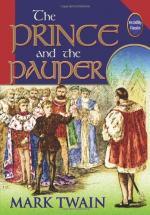In the Great Hall hangs a large picture of King Edward VI. seated on his throne, in a scarlet and ermined robe, holding the sceptre in his left hand, and presenting with the other the Charter to the kneeling Lord Mayor. By his side stands the Chancellor, holding the seals, and next to him are other officers of state. Bishop Ridley kneels before him with uplifted hands, as if supplicating a blessing on the event; whilst the Aldermen, etc., with the Lord Mayor, kneel on both sides, occupying the middle ground of the picture; and lastly, in front, are a double row of boys on one side and girls on the other, from the master and matron down to the boy and girl who have stepped forward from their respective rows, and kneel with raised hands before the King.—Timbs’ Curiosities of London, p. 98.
Christ’s Hospital, by ancient custom, possesses the privilege of addressing the Sovereign on the occasion of his or her coming into the City to partake of the hospitality of the Corporation of London.—Ibid.
The Dining Hall, with its lobby and organ-gallery, occupies the entire storey, which is 187 feet long, 51 feet wide, and 47 feet high; it is lit by nine large windows, filled with stained glass on the south side; and is, next to Westminster Hall, the noblest room in the metropolis. Here the boys, now about 800 in number, dine; and here are held the ’Suppings in Public,’ to which visitors are admitted by tickets issued by the Treasurer and by the Governors of Christ’s Hospital. The tables are laid with cheese in wooden bowls, beer in wooden piggins, poured from leathern jacks, and bread brought in large baskets. The official company enter; the Lord Mayor, or President, takes his seat in a state chair made of oak from St. Catherine’s Church, by the Tower; a hymn is sung, accompanied by the organ; a ‘Grecian,’ or head boy, reads the prayers from the pulpit, silence being enforced by three drops of a wooden hammer. After prayer the supper commences, and the visitors walk between the tables. At its close the ‘trade-boys’ take up the baskets, bowls, jacks, piggins, and candlesticks, and pass in procession, the bowing to the Governors being curiously formal. This spectacle was witnessed by Queen Victoria and Prince Albert in 1845.
Among the more eminent Bluecoat boys are Joshua Barnes, editor of Anacreon and Euripides; Jeremiah Markland, the eminent critic, particularly in Greek Literature; Camden, the antiquary; Bishop Stillingfleet; Samuel Richardson, the novelist; Thomas Mitchell, the translator of Aristophanes; Thomas Barnes, many years editor of the London Times; Coleridge, Charles Lamb, and Leigh Hunt.




